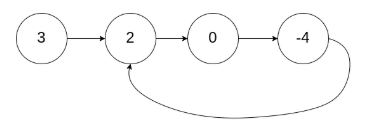leetcode142 环形链表II
【摘要】 给定一个链表,返回链表开始入环的第一个节点。 如果链表无环,则返回 null。
为了表示给定链表中的环,我们使用整数 pos 来表示链表尾连接到链表中的位置(索引从 0 开始)。 如果 pos 是 -1,则在该链表中没有环。
说明:不允许修改给定的链表。
示例 1:
输入:head = [3,2,0,-4], pos = 1 输出:...
给定一个链表,返回链表开始入环的第一个节点。 如果链表无环,则返回 null。
为了表示给定链表中的环,我们使用整数 pos 来表示链表尾连接到链表中的位置(索引从 0 开始)。 如果 pos 是 -1,则在该链表中没有环。
说明:不允许修改给定的链表。
示例 1:
输入:head = [3,2,0,-4], pos = 1
输出:tail connects to node index 1
解释:链表中有一个环,其尾部连接到第二个节点。

示例 2:
输入:head = [1,2], pos = 0
输出:tail connects to node index 0
解释:链表中有一个环,其尾部连接到第一个节点。

示例 3:
输入:head = [1], pos = -1
输出:no cycle
解释:链表中没有环。

思路:
慢指针一次一步,快指针一次两步。能相遇就是有环,反之没有环。
让一个指针从头走,另一个从相遇点开始走,然后再次相遇的地方就是入环点,不明白的画一画,想一想操场跑步就明白了。
-
/**
-
* Definition for singly-linked list.
-
* class ListNode {
-
* int val;
-
* ListNode next;
-
* ListNode(int x) {
-
* val = x;
-
* next = null;
-
* }
-
* }
-
*/
-
public class Solution {
-
private ListNode getIntersect(ListNode head) {
-
ListNode tortoise = head;
-
ListNode hare = head;
-
-
while (hare != null && hare.next != null) {
-
tortoise = tortoise.next;
-
hare = hare.next.next;
-
if (tortoise == hare) {
-
return tortoise;
-
}
-
}
-
-
return null;
-
}
-
-
public ListNode detectCycle(ListNode head) {
-
if (head == null) {
-
return null;
-
}
-
ListNode intersect = getIntersect(head);
-
if (intersect == null) return null;
-
-
ListNode ptr1 = head;
-
ListNode ptr2 = intersect;
-
while (ptr1 != ptr2) {
-
ptr1 = ptr1.next;
-
ptr2 = ptr2.next;
-
}
-
-
return ptr1;
-
}
-
}

文章来源: fantianzuo.blog.csdn.net,作者:兔老大RabbitMQ,版权归原作者所有,如需转载,请联系作者。
原文链接:fantianzuo.blog.csdn.net/article/details/103435803
【版权声明】本文为华为云社区用户转载文章,如果您发现本社区中有涉嫌抄袭的内容,欢迎发送邮件进行举报,并提供相关证据,一经查实,本社区将立刻删除涉嫌侵权内容,举报邮箱:
cloudbbs@huaweicloud.com
- 点赞
- 收藏
- 关注作者


评论(0)